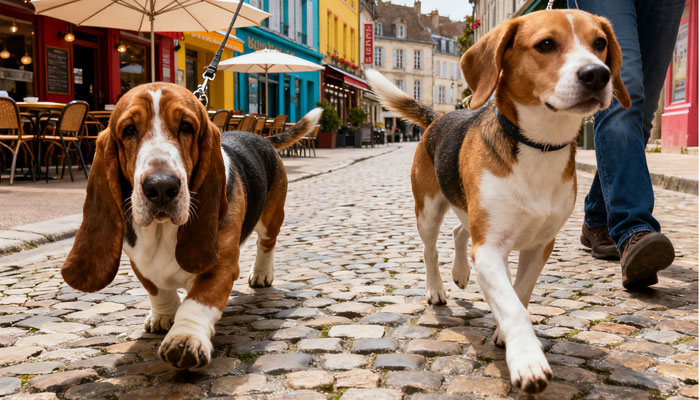The Difference Between Basset Hounds and Beagles

People occasionally get quite perplexed while deciding on Basset Hounds as well as Beagles, they just don't know how to differentiate this. Even when these two breeds are placed next to each other, those who do not know them may have a hard time finding the differences in the way they look. We are going to reveal some points of view that would help you to distinguish these two breeds better today.
I. Body Proportions
The Basset Hound is a giant dog breed, with full-grown members usually measuring 33-38 cm in height and weighing 25-30 kg. The structure of the body is characterized by having very short legs and a long body, the legs are strong but relatively short, so the initial idea that is being given is of strength and solidity. On the other hand, Beagle is an average-sized dog breed with height at the shoulder ranging from 33-40 cm and weight usually between 15-20 kg. The physique is more like harmonious and balanced, the leg-to-torso proportions are closer to those of a typical hunting dog, thus movement is less constricted and faster than the Basset Hound.
II. Head Structure
The Basset Hound exhibits a large head with a muzzle somewhat longer than the rest of the skull. The loose skin creates thick folds and the falling upper lip almost covers the lower jaw. The forehead is blemished with deep wrinkles caused by skin gathering. When combined with the diamond-shaped eyes and drooping eyelids, it becomes a sad-looking face. The Beagle's head looks less heavy and also more energetic, the skull is round and there are no wrinkles, the muzzle is straight and broad, and only a little droopy lips are seen. Its eyes are large and bright and very often they are dark brown or hazel, giving off a lively and spirited look.
III. Ear Characteristics
It is the form that best shows the difference in the visual between the two breeds. Basset Hound ears range from 30 to 35 cm. in length and have a texture similar to velvet, i.e. they are very soft. When they are hanging down, they can cover the tip of the nose and measure down to the chest. The place where the ear is attached is very low, it is almost at the same level as the eyes, and the edges give off the waves formed due to very deep curling as the ears are. The ears of Beagles are shorter and usually they do not go further than the end of the muzzle. The tips of the rounded ears are at a higher level than the eyes and ears can be moved in such a manner that 270 degrees is the maximum of the turning. The thinner ear flaps move rhythmically with the body as it moves; as a result, the scent trail technique gets faster.
IV. Torso and Limbs
The Basset Hound has a deep, extremely long body, and a broad, and thick chest. The neck of it is very muscular and has a very clear dewlap, while the dorsal side, although it is quite level, it is a bit uplifted. The hind limbs comprise of very strong bones that have been visibly cut at the stifle angles, due to which there are short but strong bursts of speed. The Beagle has a solid physique and a thin neck with little or no dewlap, a short but strong loin, and a slightly hollowed belly. As for the arms, it has the correct proportion of fore and hind legs, which are straight, well developed with muscles, and the feet have the moderate angle of the edges, giving an overall look of standing upright.
V. Coat and Color
The Basset Hound is a breed with a short and rough coat that is usually a combination of black, white, and tan (tricolor) or lemon and white (bicolor). The black on the back is forming a very noticeable “saddle” pattern. The Beagle's fur is thick and soft and mostly presents the typical tricolor (black, white, and tan) combination. The underbelly, rear legs, and tail tip must be absolutely white, which is called the “seven whites” feature. On top of its back, the black spots are almost evenly spread, thus there is a neat contrast with the white base, and the pattern is very eye-catching and easily distinguishable.
admin
-
Sale!

Washable Pet Cooling Pad for Cats and Dogs
$10.99Original price was: $10.99.$9.99Current price is: $9.99. This product has multiple variants. The options may be chosen on the product page -
Sale!

Washable Cat Window Hammock Cooling Bed
$23.99Original price was: $23.99.$22.99Current price is: $22.99. -
Sale!

Tropical Amphibian Rainforest Tank, Lizard Cage
$38.99Original price was: $38.99.$36.99Current price is: $36.99. -
Sale!

Silent 4-in-1 Waterproof Charging Dog Hair Trimmer
$49.88Original price was: $49.88.$47.99Current price is: $47.99.